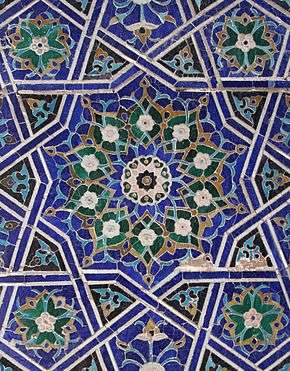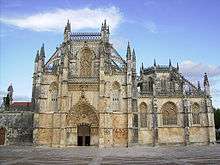Moorish architecture
Moorish architecture is the articulated Islamic architecture of North Africa and parts of Spain and Portugal (Al Andalus), where the Andalusians (Moors) were dominant between 711 and 1492. The best surviving examples are La Mezquita in Córdoba and the Alhambra palace in Granada (mainly 1338–1390),[1] as well as the Giralda in Seville (1184).[2] Other notable examples include the ruined palace city of Medina Azahara (936–1010), the church (former mosque) San Cristo de la Luz in Toledo, the Aljafería in Saragossa and baths at for example Ronda and Alhama de Granada.
Architecture
Characteristic elements of Moorish architecture include muqarnas, horseshoe arches, voussoirs, domes, crenellated arches, lancet arches, ogee arches, courtyards, and decorative tile work known as zellij in Arabic or azulejo in Spanish and Portuguese. The architectural tradition is exemplified by mosques, fortifications, and other edifices such as the Mezquita in Córdoba (784–987, in four phases); the Alhambra (mainly 1338–1390[3]) and Generalife (1302–9 and 1313–24) in Granada and the Giralda in Seville in 1184;[4] Paderne Castle in the Algarve, Portugal; the mosque of Koutoubia, Hassan Mosque, Andalusian Mosque, and University of Al-Karaouine in Morocco; the Great Mosque of Algiers and the Great Mosque of Tlemcen in Algeria; and the Mosque of Uqba in Kairouan, Tunisia. Other notable buildings include the ruined palace city of Medina Azahara (936-1010), the church (former mosque) San Cristo de la Luz in Toledo, the Aljafería in Zaragoza and baths at for example Ronda and Alhama de Granada.
The term is sometimes used to include the products of the Islamic civilisation of Southern Italy.[5] The Palazzo dei Normanni in Sicily was begun in the 9th century by the Emir of Palermo.
There is archeological evidence of an eighth-century mosque in Narbonne, France.[6]
By country
Spain
- Alicante
- Antequera
- Almería
- Badajoz
- Bailén
- Baños de la Encina Castle (Burgalimar)
- Córdoba
- The great mosque
- Medina Azahara
- Baños Califales
- Calahorra Tower
- Gormaz
- Granada
- Alhambra and Generalife
- Cuarto Real de Santo Domingo
- Albayzín
- Jaén
- Jerez de la Frontera
- Málaga
- Mérida
- Seville
- Toledo
- Trujillo
- Alcazaba
- Zaragoza
Major monuments
Caliphate of Córdoba (929-1031):
- Medina Azahara (936-1010) in Córdoba
- Mosque of Cristo de la Luz in Toledo (completed 999/1000)
- "Minaret of San Juan" (930) at Córdoba, once belonging to a mosque
- Archaeological site of the Villarrubia palace (965-66)
Period of Taifas (11th-13th century):
- the Mezquita de las Tornerías in Toledo (ca. 1060)
- the Almohad minaret known as Giralda (1184–98) at Sevilla, once part of the Great Mosque of Sevilla (1172–1176)
- Aljaferia palace (second half of the 11th century) of the Banu Hud dynasty (1039–1110) in Zaragoza;
- minaret at the Church of San José at Granada (ca. 1050)
- Almohad Minaret at Iglesia de San Juan de los Reyes at Granada
Nasrid Emirate of Granada (1212–1492):
- the Alhambra (mainly 1338-1390) and the Generalife (1302-24 in two phases), a country palace initially linked to the Alhambra by a covered walkway across the ravine that now divides them.
- Granada Hospital (Maristan) (1365-7)
- Masjid of the madrasa of Yusuf I (1349) in the so-called Palacio de la Madraza
- New Funduq of Granada (14th century)
- Qaysariyya of Granada (15th century)
Portugal

Algeria, Morocco and Tunisia
There is a high concentration of Moorish architecture in the Maghrebi states of Morocco, Algeria, and Tunisia mainly in the cities of Marrakesh, Rabat, Fez, Tlemcen, Algiers, Tunis, and Testour.
Gallery
 Mosque–Cathedral of Córdoba, Spain - Horseshoe Arch
Mosque–Cathedral of Córdoba, Spain - Horseshoe Arch.jpg) Mosque–Cathedral of Córdoba, Spain - Double horseshoe arches allowing for greater ceiling height
Mosque–Cathedral of Córdoba, Spain - Double horseshoe arches allowing for greater ceiling height Court of the lions, Alhambra Spain
Court of the lions, Alhambra Spain Alhambra, Granada, Spain - central court and gardens were a feature uniquely Moorish
Alhambra, Granada, Spain - central court and gardens were a feature uniquely Moorish- Muqarnas in the Alhambra, Granada, Spain - muqarnas allowed for 2 dimensional patterns to be used in 3 dimensions to embellish the transition between the square base to a dome.
See also
Notes
- ↑ Curl p. 502.
- ↑ Pevsner, The Penguin Dictionary of Architecture.
- ↑ Curl p.502
- ↑ Pevsner, Niklaus. The Penguin Dictionary of Architecture
- ↑ The Industrial Geography of Italy, Russell King, Taylor & Francis, 1985, page 81
- ↑ Islam Outside the Arab World, David Westerlund, Ingvar Svanberg, Palgrave Macmillan, 1999, page 342
References
External links
| Wikimedia Commons has media related to Architecture of Al-Andalus. |

-Jerusalem-Temple_Mount-Dome_of_the_Rock_(SE_exposure).jpg)


